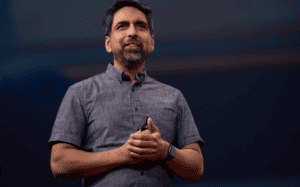Today, be it for school or college, Khan Academy has become one of the most popular platforms that students turn to for getting their doubts cleared. The man who is behind it all is Salman Khan, who is a former hedge-fund analyst and has a Master’s degree in Computer Science from MIT.

While Khan Academy began its journey by primarily focusing on STEM subjects, it now also covers humanities. Additionally, the platform provides remote learning resources and complimentary tools for educators and parents to monitor student progress. Currently boasting over 10 million global users accessing more than 5,000 courses, Khan’s innovative approach has garnered widespread admiration and emulation. During a comprehensive discussion, I engaged with the 37-year-old Khan for over two hours, combining in-person and telephone conversations. The following is a condensed and edited account of our dialogues.
True calling
In an interview with the New York Times, Khan shared that his journey began back in 2004 when he offered to tutor his 12-year-old cousin Nadia, who was struggling with math. The tutoring classes continued over the phone, and soon he realized how essential personalized learning was for students. Eventually, he found himself tutoring around 15 cousins. However, scheduling challenges prompted him to adopt a more scalable approach. In 2006, Khan began recording tutorial videos and uploading them to YouTube, allowing learners to access the material at their own pace. As things started getting out of hand, he decided to create a website for them to practice problems, using Yahoo Doodle for visualizing calculations during phone sessions.
The transition to internet videos occurred two years later when a friend questioned the scalability of Khan’s lessons. While he was initially skeptical about YouTube, Khan eventually tried making tutorial videos. To his surprise, the format gained popularity, with his cousins telling him that they preferred the online explanations more. The demand grew, reaching a broader audience, and by 2008, he was teaching tens of thousands of learners each month.
Khan started recording his educational videos in a makeshift “studio” at his home, specifically in a closet. The setup consisted of a $900 desktop from Best Buy, a $200 microphone, a pen tablet from Amazon, and screen capture software. In this humble space, Khan drew on an art program on his computer while providing explanations into the microphone.
Around 2009, Khan made the decision to leave his job at the hedge fund to dedicate himself full-time to building the Khan Academy.
Khan’s approach
Salman acknowledges that he may not have made it so far without YouTube, as it gave him an opportunity to upload his videos at no cost. He also highlights the fact that, before YouTube, streaming videos online meant one had to pay exorbitant charges. Even though having YouTube made things easy for him, at the end of the day, it was his content that did the magic.
On closer scrutiny, one would notice that in Khan’s videos, viewers didn’t see him; instead, cartoon-like equations were drawn, accompanied by friendly and encouraging voice-overs. The approach aimed to strike a balance, injecting enthusiasm into STEM teaching without sacrificing the core mathematical concepts. Khan’s goal was to make the material more interesting and fun for the students.
Are the tutorials like Massive Open Online Courses?
Khan Academy tutorials distinguish themselves from Massive Open Online Courses (MOOCs) offered by universities in several ways. Unlike traditional MOOCs that transplant regular courses into the virtual realm with a fixed schedule and exams, Khan Academy emphasizes a self-paced, mastery-based approach.
Instead of conforming to a predetermined schedule, users on Khan Academy begin by taking a test to assess their current knowledge level. The platform then tailors lessons based on individual progress, ensuring mastery of each concept before advancing to the next. This personalized learning model allows users to move at their own pace, ensuring a comprehensive understanding of the material.
Support from others
The Khan Academy transitioned into a formal organization in 2008, incorporating as a 501c(3) nonprofit. Salman Khan initially worked on the project during his spare time until September 2009 when he committed to it full-time, relying on his savings for the first nine months. The turning point came with a significant donation from Ann Doerr.
In September 2010, Khan Academy secured substantial grants, including $2 million from Google and $1.5 million from the Bill and Melinda Gates Foundation. This influx of funds marked the beginning of organizational expansion. Sal Khan enlisted Shantanu Sinha from McKinsey & Company as President & COO, leveraging their long-standing friendship and shared academic history. The team was further strengthened with the recruitment of Ben Kamens and Jason Rosoff from Fog Creek Software to lead software development and design. In October 2010, the growing team moved into their first official office space, solidifying the foundation for Khan Academy’s continued growth.







